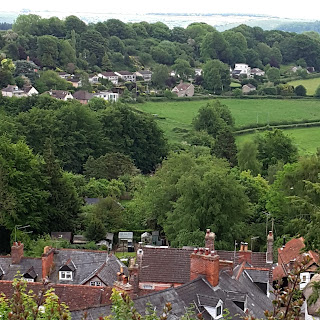At my flouncy and flowery B&B (plastic flowers) I start each day with baked beans, greasy mushrooms and a couple of fried eggs with toast and tea.
That set me up for a walk out to Old Sarum, where the original Salisbury Cathedral was built in the thirteenth century. Little is left but it's a lovely site managed by English Heritage. It is like a Maori hill fort, with circles of fortification around the hilltop. There's a good view from Old Sarum to the current cathedral, which boasts the tallest spire in England.
So I wasn't even going to go in to the Cathedral, being slightly underwhelmed by the exterior and slightly wary of the £6.50 'donation' for admission. C'mon, pay up. Drawn in more by the promise of cloisters than by the opportunity to see a version of the original Magna Carta, in I went. And was nabbed at the door by a pair of enthusiastic greeters, keen to set me off in the right direction while giving me a good earful of details about successive building restorations and which bits of stained glass could be said to original, about which they disagreed between themselves for a while. I extracted myself with some difficulty, only to be caught a bit further on by one of them, who then insisted on explaining the shallow foundations. Apparently the water table is measured daily by plunging a simple dip stick down through a special tile in the floor, and if there's any variation beyond 3 to 4 feet, adjustments are made via a system of gates and weirs on the nearby River Avon. As long as the level is stable, the foundations of the Cathedral are protected from disintegration. Very interesting but distracting. For the clean lines and proportions of the structure itself were arresting enough and I was most happy to prowl around alone.
 |
| The Cathedral clock doesn't have a face. It rings a bell on the hour, but that has been turned off except for ringing out at 11.00am on Tuesdays and Thurdays. |
 |
| Officially my favorite Cathedral (for now) |
I was told there's a fifteenth century Library downstairs with over 10,000 books. "We have a wonderful librarian" the Greeter told me. "She's really lovely".
You can do a tour that ends with tea and scones, but at £22.00 I'm passing on that, sadly.
I love cloisters, and Salisbury's didn't disappoint.
Posted while taking tea in the gardens outside the Salisbury Museum, sitting under a sun umbrella with views of the cathedral.



































